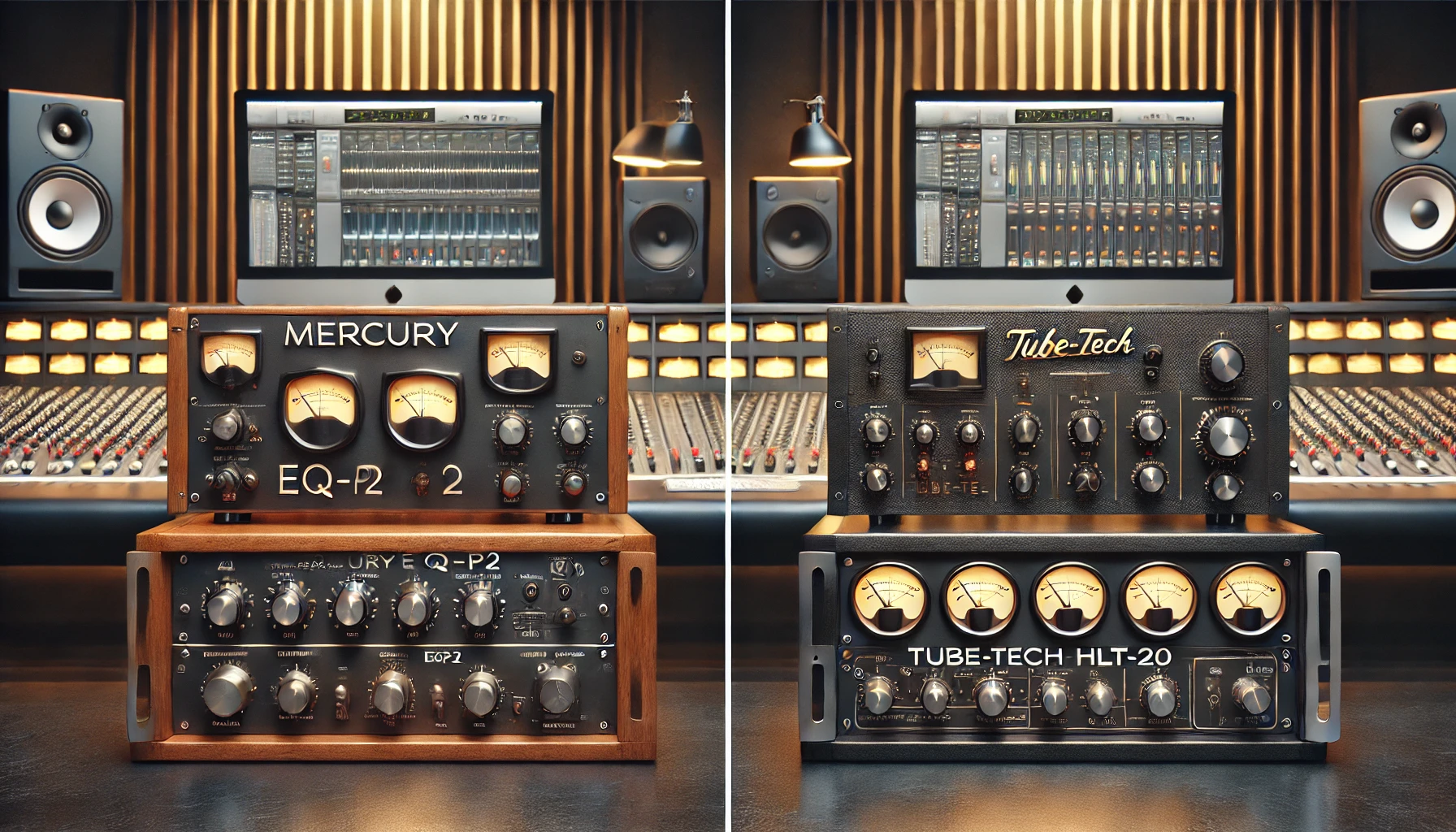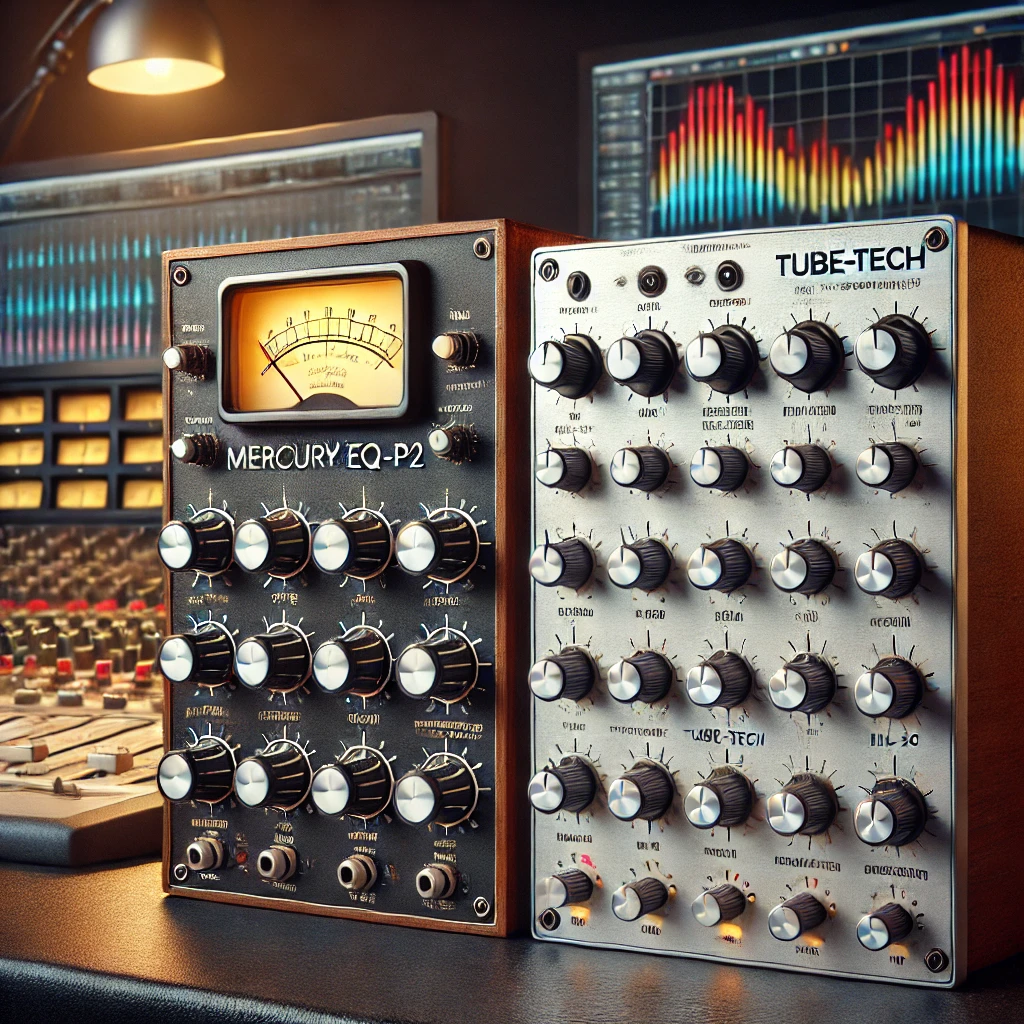- December 25, 2024
Compare Mercury EQ-P2 versus Tube-Tech HLT-20 Mastering: A Comprehensive Guide

Compare Mercury EQ-P2 versus Tube-Tech HLT-20 Mastering: A Comprehensive Guide
In the world of professional audio, equalizers play a pivotal role in shaping sound, especially during the mastering process. Two popular names that often come up in discussions about high-end analog EQs are the Mercury EQ-P2 and the Tube-Tech HLT-20. Both of these units are beloved by engineers for their distinct characteristics and abilities to enhance a mix. In this article, we’ll compare the Mercury EQ-P2 versus Tube-Tech HLT-20 mastering, exploring their Technical Design Philosophy, Frequency Processing Capabilities, Sonic Character, and more.

Technical Design Philosophy
The Mercury EQ-P2 and Tube-Tech HLT-20 each follow a unique design approach, influencing their sound and usability.
- Mercury EQ-P2: This EQ is inspired by the classic Pultec EQP-1A design, known for its tube-based, passive circuitry. The design uses a passive EQ network with tube amplification, resulting in a smooth, musical tone. It’s ideal for engineers seeking warmth and subtle frequency enhancements without introducing too much coloration.
- Tube-Tech HLT-20: In contrast, the HLT-20 uses a more modern hybrid approach, combining tube technology with active, solid-state components. This gives it a cleaner and more precise sound, allowing for more detailed adjustments. It’s perfect for those who need versatile tonal shaping, with a focus on precision.
Frequency Processing Capabilities
Both EQs are designed to manipulate frequencies effectively, but they offer different methods and controls.
- Mercury EQ-P2: This EQ features low and high-frequency boost and cut controls. The Pultec-style design allows for the famous “Pultec Trick,” where you can boost and cut the same frequency simultaneously, creating a rich and balanced sound, especially in the lows and highs. However, its frequency control is limited to just two bands, which might not be ideal for more detailed EQing.
- Tube-Tech HLT-20: The HLT-20 offers a more traditional approach with dedicated low, mid, and high bands. It provides more flexibility than the Mercury EQ-P2, allowing engineers to adjust midrange frequencies precisely. The tilt control is also a unique feature, allowing users to adjust the overall tonal balance between low and high frequencies.
Sonic Character
The sonic character of each unit is where their differences become more noticeable.
- Mercury EQ-P2: The Mercury EQ-P2 offers a more vintage, warm sound, perfect for those seeking a smooth, musical EQ. The tube circuitry imparts a slight harmonic distortion that adds richness and depth to the sound, particularly in the low end and high frequencies. It’s great for adding analog warmth to any mix or master.
- Tube-Tech HLT-20: The HLT-20 tends to be cleaner, with a more controlled sound. While still offering the warmth of tube amplification, it’s more transparent and precise in its tonal adjustments. This makes it an excellent choice for mixes that require clear and accurate frequency shaping without too much coloration.
Use Cases in Mastering
Both of these equalizers can be invaluable in the mastering process, but their suitability depends on the desired result.
- Mercury EQ-P2: This EQ is perfect for enhancing the overall tonal quality of a master, especially when a vintage analog feel is desired. It’s particularly effective for boosting high frequencies, adding shimmer to vocals and instruments, and giving the low end a tight yet full sound.
- Tube-Tech HLT-20: The HLT-20 is excellent for more precise tonal corrections. It’s ideal when you need to balance frequency ranges more accurately, especially in dense mixes where specific adjustments in the midrange can make a significant impact. It’s often used for fine-tuning a master, giving it clarity without over-processing.
Flexibility and Workflow
The ease with which you can incorporate these units into your workflow is crucial, especially in busy studio environments.
- Mercury EQ-P2: With fewer controls, the Mercury EQ-P2 is incredibly simple to use. It’s perfect for engineers who want quick and musical adjustments without having to dive deep into parameters. It’s a go-to tool for those who prefer a hands-off approach with predictable results.
- Tube-Tech HLT-20: The HLT-20, while more flexible, can be more complex. With its multiple bands and tilt control, it allows for greater precision but requires a more in-depth understanding to achieve the perfect balance. This can be beneficial for mastering engineers looking to fine-tune specific frequencies.
Genre-Specific Applications
Both EQs serve a wide range of genres but excel in different areas.
- Mercury EQ-P2: This EQ is particularly popular in genres that benefit from analog warmth, such as jazz, blues, and classic rock. Its smooth, musical sound is ideal for adding depth and character to acoustic instruments and vocals.
- Tube-Tech HLT-20: The HLT-20 is versatile enough to be used across many genres but shines in modern pop, electronic, and orchestral mixes, where precise tonal adjustments are essential. It works wonders in dense, layered mixes, providing clarity and definition.
Analog vs. Digital Workflow
When considering an EQ, it’s important to think about how it integrates with your analog vs. digital workflow.
- Mercury EQ-P2: The Mercury EQ-P2’s analog warmth makes it an excellent choice for a hybrid studio setup, where both analog and digital tools are used. Its smooth, musical tone pairs well with digital recordings, adding a natural analog touch to the sound.
- Tube-Tech HLT-20: The HLT-20 can also be used in hybrid setups but offers more precise control. Its modern design allows it to work well in fully digital environments, where engineers need a clean and detailed EQ that complements digital sources.
Value for Money
- Mercury EQ-P2: While the Mercury EQ-P2 offers fantastic value for those seeking a vintage analog sound, its limited controls might not justify the price for everyone. It’s best suited for those who prioritize tone over flexibility.
- Tube-Tech HLT-20: The HLT-20 is more expensive but offers a wider range of tonal control. For those looking for flexibility and precision, it can be a solid investment that provides high-quality results for years.
Direct Comparisons
When directly comparing the two, the Mercury EQ-P2 is the go-to choice for vintage sound and musicality, while the Tube-Tech HLT-20 is ideal for precise, modern tonal shaping. Both are high-quality units, but their applications differ based on your needs.
Alternatives to Consider
If you’re exploring options, there are several alternatives worth considering:
- Pultec EQP-1A (similar to Mercury EQ-P2 for analog warmth)
- Manley Massive Passive (offering flexibility similar to Tube-Tech HLT-20)
- SPL Passeq (another tube-based EQ with modern control)
In conclusion, when you compare Mercury EQ-P2 versus Tube-Tech HLT-20 mastering, the best choice depends on your sound preferences, workflow needs, and budget. The Mercury EQ-P2 is excellent for those seeking classic analog warmth, while the Tube-Tech HLT-20 provides more precise control for modern, versatile EQ adjustments.